Our family of five has been sea kayaking and canoeing for several years around the islands and coastline of Maine’s mid-coast. Paddling took us where we wanted to go, but on some days when a breeze came up and we were fighting headwinds home, I started to think about a larger boat, one that would sail well to weather and would row easily when the wind died. I wanted it to have some of the simplicity of our kayaks or canoes and allow us to continue day-trip exploration and overnight adventures.
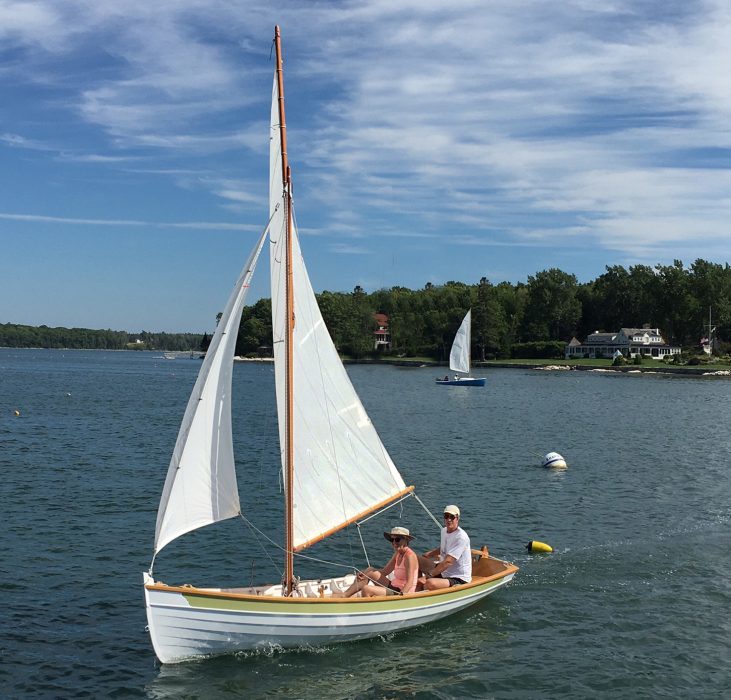 Buzz Bilik
Buzz BilikThe gunter rig comes into its own in a 10-knot breeze and the boat can get up to 6 knots and better.
I wanted a boat that would fit the Maine-coast aesthetic, be light enough to launch easily, and could remain watertight after prolonged dry storage, so I focused on glued plywood construction. The length had to be around 18′, small enough to fit in our barn, alongside the kayak fleet, yet big enough to feel safe and comfortable out in open water.
It didn’t take long for the Penobscot 17, designed by Arch Davis, to get to the top of my list. Even at a first look it seemed the perfect blend of all my requirements, and it was beautiful from any angle. The sweeping sheer, the shapely wineglass transom, and the almost-plumb bow made the Penobscot 17 look like it was designed a century ago.
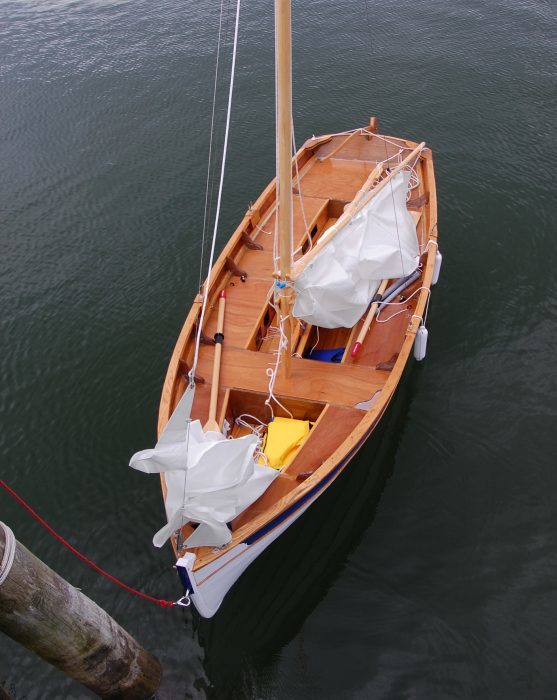 Elliott Arons
Elliott AronsThe gunter rig requires standing rigging—a forestay to a stemhead fitting and shrouds to the forward pair of oarlocks—but both the schooner and the ketch rig have freestanding masts.
My wife bought the set of Penobscot 17 plans as a Christmas gift to me. The plans package is great, with everything laid out very clearly. Eight large bluelines detail every stage of the construction, and two large Mylar sheets provide full-sized patterns for the stem, transom, bulkheads, centerboard, and trunk, rudder, and other parts. A lengthy spiral-bound book covers much of the building process and includes a complete materials list.
The Penobscot 17 is not a project beyond most craftsmen with moderate experience. Over the years I’ve built furniture, stitch-and-glue kayaks, and skin-on-frame kayaks, and I’ve restored cedar-and-canvas canoes, so I felt comfortable tackling the building. I figured a good year working part-time would result in a nice boat. I was familiarizing myself with the project when I discovered a beautiful Penobscot 17 for sale online on the WoodenBoat website. After speaking with the builder, Jim Schlough, by phone and seeing a few pictures, I knew it was built as well or better than I could have, would probably cost less than I might have spent to build my own, and would get us out enjoying the boat a year sooner.
We’ve sailed PISTACHIO for two seasons now and have not been disappointed. Launching and retrieving the boat by trailer is easy, either working alone or with my wife. We can step the mast, get her rigged, and be on the water in 15 or 20 minutes. We keep the boat on a mooring during the summer, but she would be easy to put in and take out on a daily basis if needed. We pull PISTACHIO with our Subaru Outback, which has more than enough power for a boat and trailer of this size.
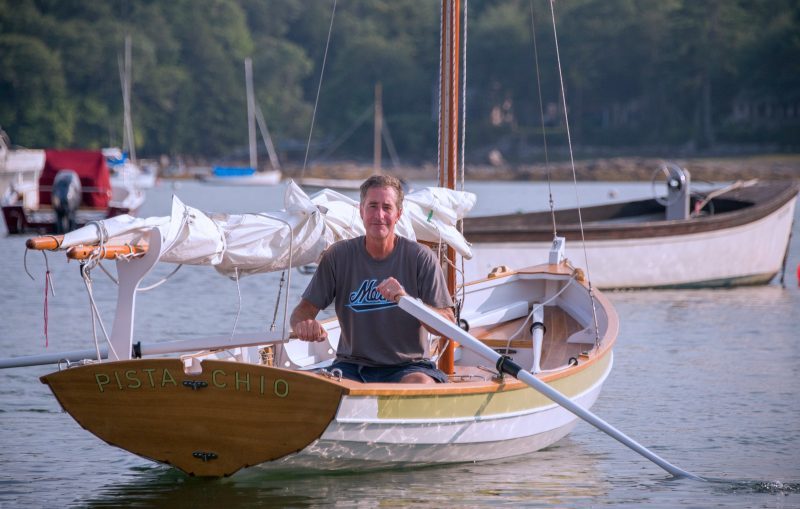 Elizabeth Root
Elizabeth RootThe boat has two rowing stations and can be rowed tandem, but the author, seen here rowing solo, found the boat was so easily driven that he stopped bringing a second pair of oars.
The Penobscot 17 has two rowing stations and rows easily from either. Although there aren’t any foot braces, I haven’t felt the need for them. It would be simple to attach some to the floorboards if we were so inclined. In a departure from the plans PISTACHIO has dedicated fittings for the shrouds, leaving the forward oarlocks available for rowing, but if the mast of our sloop rig is up, it doesn’t allow the forward rower to lean back to finish the stroke with full power. The ketch and schooner rigs are rowed solo from the forward station when the masts are in place. The boat rows well enough with one person at oars that we quit bringing the second pair along.
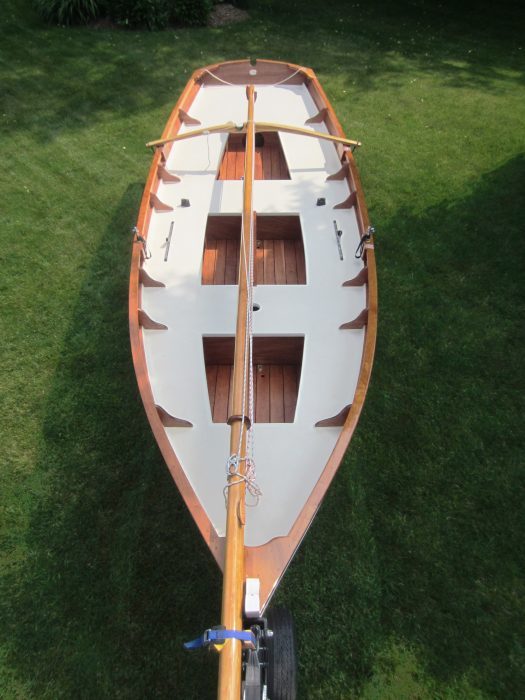 Rick Kapellen
Rick KapellenThe side benches and thwarts, all on the same plane, provide unlimited seating options and an easy conversion to a roomy sleeping platform.
The cockpit layout provides a generous seating arrangement in what’s more a deck with footwells than thwarts and benches. The seats along the sides and stern are particularly good spots to lie down and take a nap while at anchor or even while underway. The boat easily fits one to four people; when waters are calm, we’ve had as many as six or seven adults aboard while I’ve been rowing, and it’s very stable and solid. With a 15′ 8″ waterline length and pretty substantial skeg, the boat tracks beautifully. Once up to speed, PISTACHIO cruises without a lot of effort on the oars. I haven’t measured her speed while rowing, but it is not appreciably slower than our kayaks.
Davis drew the Penobscot 17 with three rigs: gunter sloop, ketch, and schooner. PISTACHIO is set up with the gunter sloop rig, which is the only stayed rig of the three layouts. It has two shrouds and a forestay. The mast simply slides through a hole in the forward deck and then drops into a square step on the keel. All the middle bulkheads have open cutouts for storage, so it’s easy to see the foot of the mast to make sure it lands securely. It’s simple to raise the main and jib and be underway in a couple of minutes.
Our Penobscot 17 cruises along in light air and really gets going with 5 to 10 knots of wind. In a 10-knot breeze she easily makes 6 to 8 knots according to GPS. We have only one set of reefpoints in the main, so we haven’t been out in much over 15 knots. I think it would be good to add a couple more reefs for when winds unexpectedly get stronger.
The seating options are quite varied, and there’s never a problem shifting weight across the boat to respond to gusts and lulls, or to fine-tune fore-and-aft trim. The boat is unballasted and doesn’t have an exceptional amount of freeboard, so a good puff can put a rail down near or in the water. A friend took the helm of PISTACHIO last summer and dipped a rail for a bit, which created a bit of excitement for us, but the boat didn’t capsize, and to my surprise not much water came aboard. The boat seems to like to roll up on her curves and stay there. The Penobscot 17 is built with substantial foam under the seats and watertight compartments in the bow and stern. There have been very few times I’ve felt we were at much risk of capsizing.
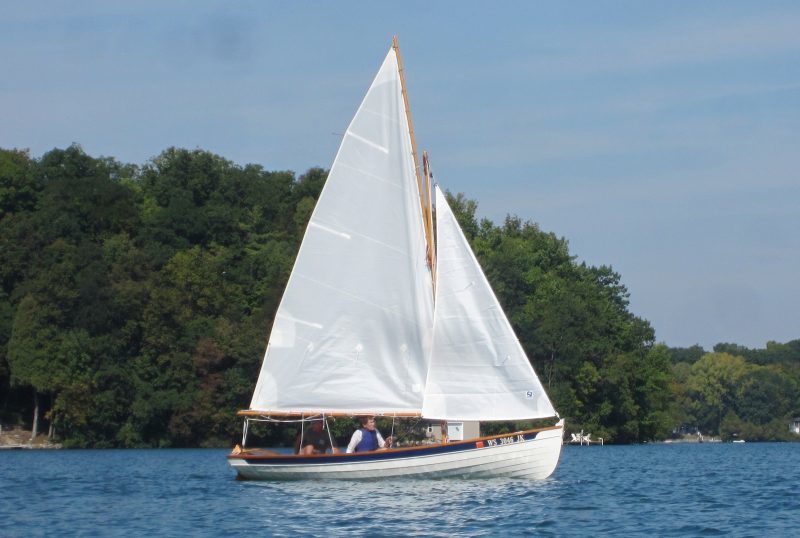 Courtesy of Rick Kapellen
Courtesy of Rick KapellenIn light air, the Penobscot 17 can still make satisfactory headway.
On most points of sail the boat tracks and stays on course, likely because of the fairly large keel/deadwood and centerboard. The tiller is attached to the rudder with a very simple mortise-and-rope lock and requires just a very light touch. The rudder blade is pretty large, and although it does kick up, it’s simple to lift off and stow, so I tend to do that when beaching. The rig is very well balanced, and I’ve noticed almost no weather helm. We’ve been in some short 2′ chop and bigger swells, and even when beating into the wind, things stay dry inside. It’s a comfortable ride most of the time.
The Penobscot really excels while cruising among small islands. It is so simple to drop the sails in the lee of an island, pop the oars in, and row ashore. Schlough designed a simple boom crutch that pivots off the port end of the aft bulkhead. It keeps the boom off the centerline of the boat and gives the rower room to sit comfortably with the boom and sail off their right shoulder.
With her shallow draft we usually pull up to a beach, unload, and then let her float off the beach with an anchor or tied to shore. As for leaving her on a beach, I think using a couple of fenders as rollers would work to get her up or down, but with plywood bulkheads and a lot of hardwood trim, she does weigh a few hundred pounds. Depending on angle and make-up of the beach as well as tide heights, it could be harder to pull her around on shore. With the round bilge and deadwood, she will want to lie to one side as well. Usually the anchor seems simple, so we go that route.
I feel the Penobscot could be a good camp-cruiser, and I’ve been thinking of designing a boom tent for sleeping aboard. The footwells could easily be covered to create sleeping platform for two people. The Penobscot 17 can carry quite a load of camping equipment. There are open compartments under the transverse seats which provide spots to tuck gear, although water can slosh through these, so it’s good to stow things in dry bags. There is also stowage under the perimeter seats, but it is a bit more limited. Some cargo netting could work well to hold things in place there. We usually keep some gear in dry bags in the footwells also.
 Jim Root
Jim RootThe keel and the deadrise will set the hull over on its bilge if the boat is dragged up on the beach, so anchoring is preferred for stops ashore.
I’ve been really impressed with the Penobscot 17. It sails and rows well and is easy to trailer and store. Almost every time we’re out, someone stops and asks about the boat, and I’m always a bit sad to say we did not build her, but I am proud to be the owner of such a beautiful boat.![]()
Jim Root has posted videos of his Penobscot 17 rowing and under sail (1,2,3). He makes his home in Barrington Hills, Illinois, where he works in communications and advertising. He has a passion for painting and has a second home in Round Pond in mid-coast Maine where he finds subjects for his paintings of landscapes and boats. You can see his paintings at his website.
Penobscot 17 Particulars
LOA/17′0″
LWL/15′ 8″
Beam/5′ 4″
Draft, Board up/9.5″
Draft, Board down/3′ 0″
Weight/260 to 300 lbs
Sail area
Gunter rig/132 sq ft
Ketch/118 sq ft
Schooner/139 sq ft

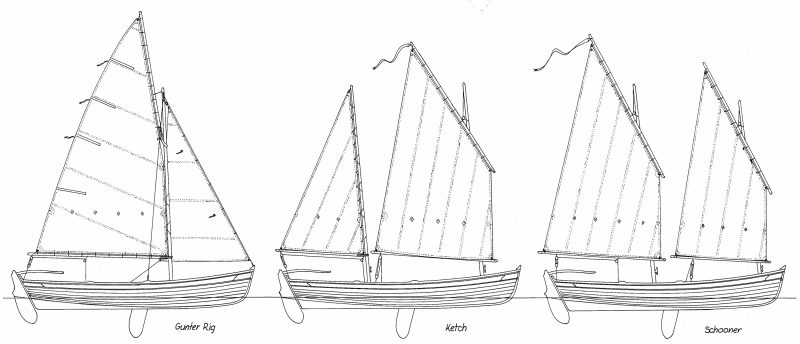
The Penobscot 17 is available as a plan set, which includes full-sized patterns and a building manual, for $200. A bulkhead kit, including the six bulkheads, transom, stem, and plans, costs $975. Other kits are available from Arch Davis Designs.
Is there a boat you’d like to know more about? Have you built one that you think other Small Boats Monthly readers would enjoy? Please email us!
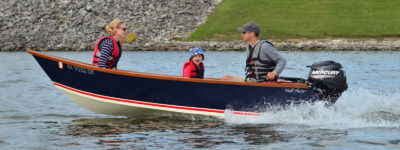
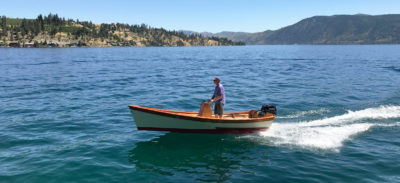
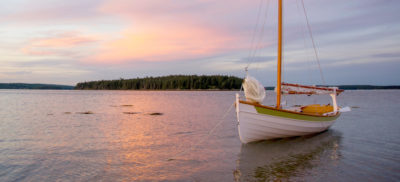
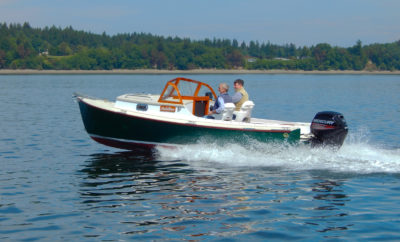
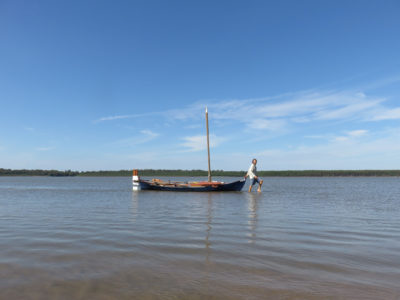
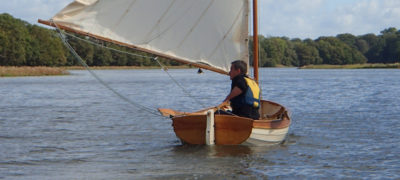
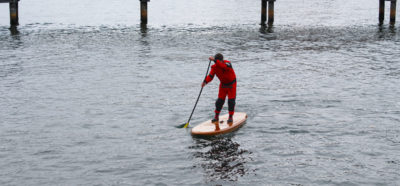

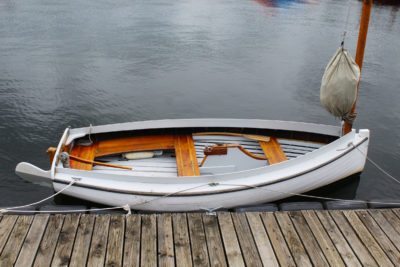
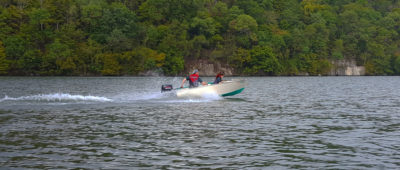
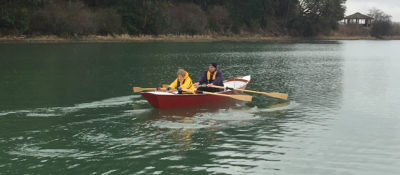
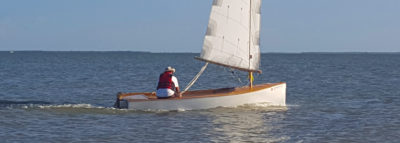
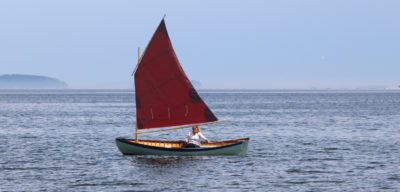
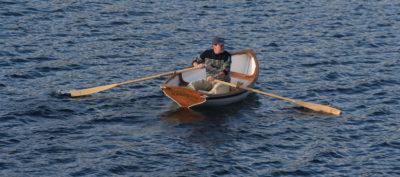
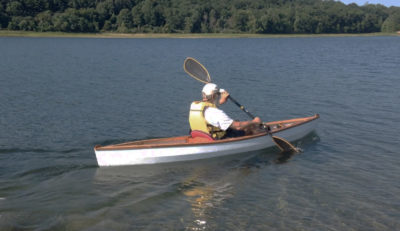
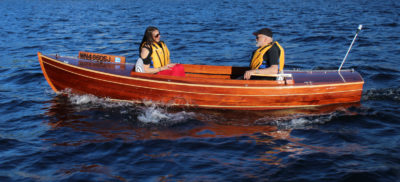
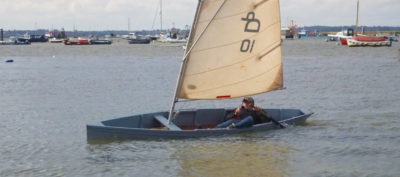
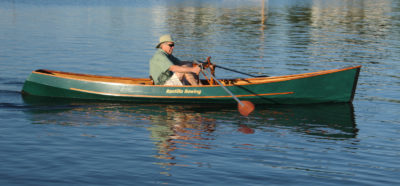
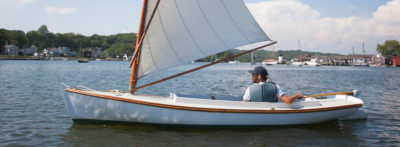
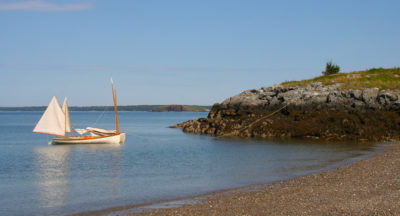
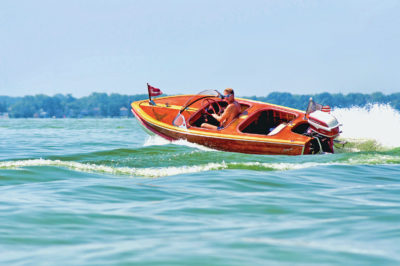
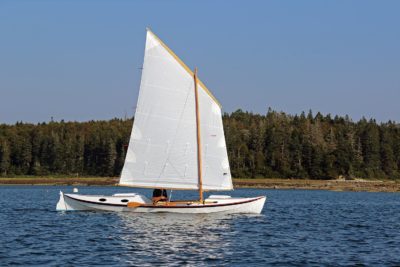
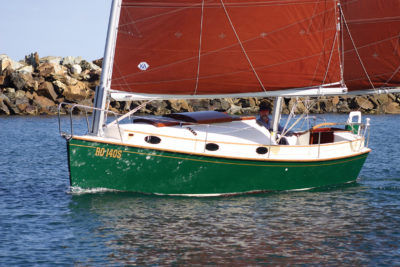
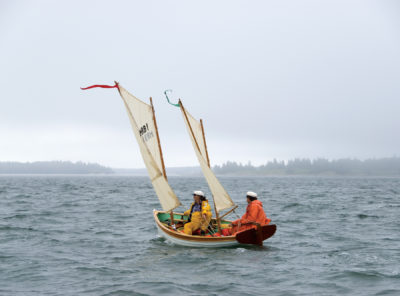
We were impressed with the Penobscot 17 as well and owned a schooner rig, beautifully fitted out by Turner Matthews and Bob Pitt. She was well travelled with previous owners Turner and Doug Engh, having attended the Small Reach Regatta, Mid Atlantic Small Craft Festival, Cedar Key, and Florida 120. A proven camper cruiser and very fast under the schooner rig. And a real head turner. She has a new home in Pensacola nearby. We are currently building her little sister, the Penobscot 14.
You can read a bit about her on our Small Boat Restoration blog.
Great blog, Kent! I would love to see her set up for camp cruising!
Great looking boat and build. Good choice of rig. I sail the Maine Mid Coast every year at the end of August to the beginning September—maybe we will cross paths sometime.
A new owner of a Penobscot 17′ from the Chesapeake Bay, but built in Pennsylvania, I am in love with this “beautiful swimmer.” I have moved her south to North Carolina so she can join in with a fleet of other traditional small-craft skiffs sailing the southern Outer Banks near Cape Lookout. I did have to cut out and re-fabricate a new mahogany centerboard because it was permanently wedged from warping and internal obstruction. I love the way she begs to sail, so easy an attitude and glides through the water with grace!
I look forward to introducing her to her sailing heritage after having been garaged for the past decade! I know she will turn heads wherever we go. Thank you for this article. As a life-long sailor and restorer of small craft, I am smitten!
I built the same boat beginning in 2009—schooner rig. I had the same problem with the centerboard. My advice to a new builder would be to be careful that the material for the centerboard are dry and use several—three to five—pieces glued up to make the full width. I used white oak but the pieces were wider—hence the cupping.
Recently bought the plans from Arch, and I’m setting up shop and will take the Penobscot 13 course at WoodenBoat School this summer. Not new to inshore or offshore boats, but never sailed. My wife said: “But you will flip the boat.” Knowing nothing, I said: “Not if I pull the line from a jam cleat and drop the sail.” I hope I’m right. Really looking forward to starting the class.
The easiest way to avoid flipping the boat is to leave the main sheet in your hand. A small boat will react to gusts so fast you will not be able to uncleat the halyard in time, but you can always ease the sheet. For years I sailed a Comet, a 300-lb boat with 125 sq ft of sail and was able to avoid swamping it, although couple times I came really close. And always wear a life vest so when you flip the boat… Good luck with it.
I built my Penobscot 17 in 2012 and have sailed it in Monterey Bay. I did capsize moving along down wind and then jibing, she rolled over pretty quick. With two of us in the water, I climbed up on the hull and grabbed the centerboard, as the boat rolled back up my partner boarded and the boat floated with about 6″ of freeboard. I scampered aboard, and we were able to sail into the Santa Cruz Harbor. The fuel dock attendant gave us a 5 gallon bucket and we bailed her out. Nothing lost, nothing broken, except for a wet iPhone. I have since built a Somes Sound 12.5 which has a 600-lb keel, so I am looking to sell the Penobscot.
Nice article, Jim. I built one in 2014 and live in Friendship. We come to Round Pound often to eat lobsters. I like the idea of putting the boom to the right while rowing. This should make it easier to row. And it is beautiful to look at and fun to sail or row.
Thanks, Elliot. When we’re in Round Pond the boat is moored on the north side of the harbor, not far from the lobster docks. We are usually around either sailing or kayaking so hopefully we can run into you at some point. Would be fun to see your boat.
Great article. It’s a beautiful looking boat with great lines. Thank you.
Got a set of plans and intend to start building a “parts kit” (stem, bulkhead, etc) this winter! The rest will go together after I retire next April. She will hopefully be a worthy alternative to my Pooduck Skiff, WAUPOOS, for camp cruising under oar and sail.